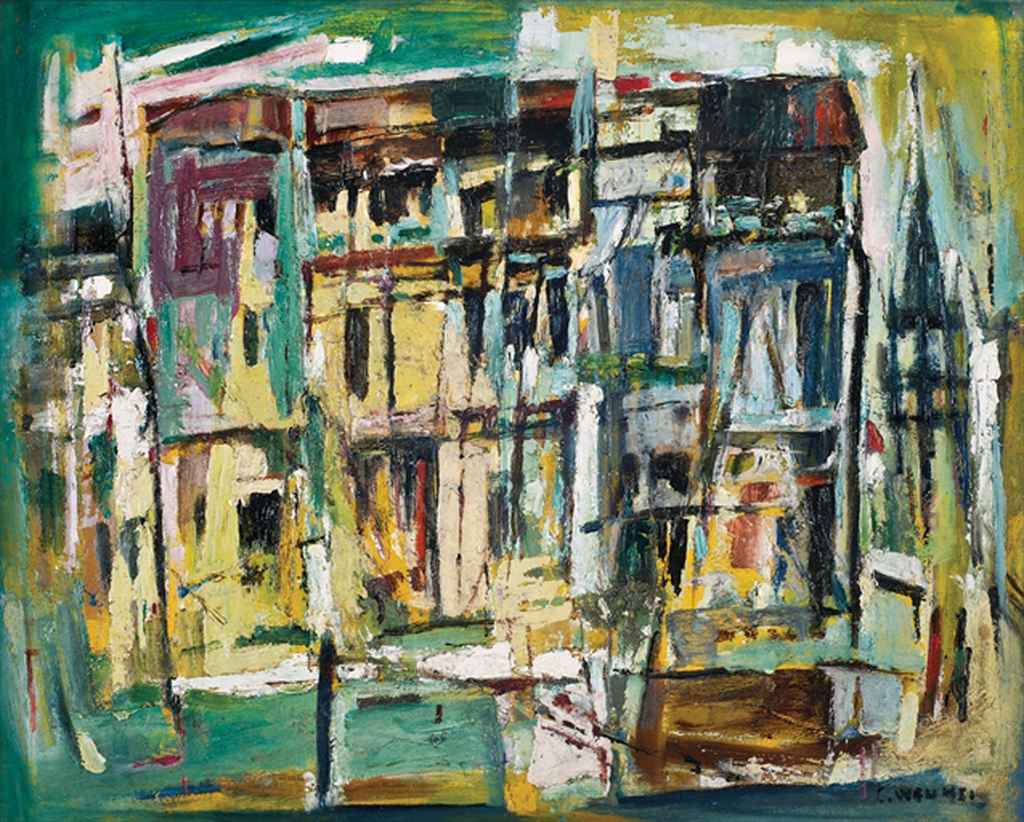Chen Wen Hsi (1906 – 1991)Gibbon Family signed and inscribed in Chinese (upper left) ink and colour on paper 141 by 77 cm. 55 1/2 by 30 3/8 in.FootnotesProvenance Acquired directly from the artist's studio Private collection of Dr Audrey Chin, Singapore 陳文希 猿掛岳山藤間 款識:猿掛岳山藤間 孟山人句 文希記 鈐印:陳文希、白宮、人長壽 水墨設色紙本立軸 來源 藏家直接購自藝術家本人 新加坡Dr Audrey Chin私人收藏 Born in 1906 in China's Jieyang county, Guangdong province, Chen Wen Hsi is considered one of the most renowned pioneer painters in Singapore's modern art scene. Chen was trained in the Shanghai Art Academy and the Xinhua Academy of Fine Arts in the late 1920s. Before he settled in Singapore around 1949, he was already a recognised artist in southern China. In Singapore, Chen nurtured a new generation of artists at both The Chinese High School and Nanyang Academy of Fine Arts. His landmark voyage to Bali in 1952, together with fellow artists Cheong Soo Pieng, Chen Chong Swee and Liu Kang, would act as a catalyst for developing the Nanyang Art Style that later triggered the modern art movement in Singapore. Chen was equally adept at Chinese ink painting and Western oil painting, and eventually developed his distinctive style of combining both art forms. The artwork that Chen created during the 1950s was mainly rendered in the Shanghai School's xieyi style characterised by expressive and freehand brush work. As his artistic style evolved over time, Chen became noted for his innovative approach to ink painting by incorporating both Chinese and Western painting techniques into his work. In addition, Chen excelled in drawing various types of animals, for his love of wildlife. He kept a mini zoo in his bungalow garden, so that he could closely observe the individual characteristics and movements of the animals that he reared and painted. Chen's paintings of lively gibbons are among his most famous—his artistic legacy continues to live on the reverse design of Singapore's fifty-dollar note, which features a pair of gibbons from his work Two Gibbons Amidst Vines. The present lot Gibbon Family is a large-size naturalistic depiction of gibbons on a hillside in the mountains. Chen employs fluid and energetic brushwork with a careful precision to capture the playful movement of gibbons swinging between branches and to exude a sense of dynamism and vitality. Its inscription cites a verse from the poem titled Myriad Mountain Pool by Meng Haoran (689/691-740), one of the most prominent Chinese poets during the Tang Dynasty. The verse, which describes a scene of gibbons brachiating amidst hanging vines, is skilfully visualised through the composition and subject matter of this visually arresting painting. Gibbon Family exemplifies Chen's meticulous attention to detail and marvellous rendering of the ultimate harmony of existence in nature. 1906年生於中國廣東省揭陽縣的陳文希是新加坡現代藝術界最著名的先驅畫家之一。1920年代末,他曾先後在上海美術專科學校和新華藝術專科學校習畫。陳文希約於1949年定居新加坡,當時他的畫作便已在中國南方廣受認可。陳文希在新加坡華僑中學和南洋美術專科學校(今南洋藝術學院)任教時,栽培了一批新加坡新時代的藝術家。1952年,他和畫友鍾泗濱、陳宗瑞和劉抗結伴前往印尼峇里島寫生,此趟深具劃時代意義的旅程催化了南洋畫派的發展,進而觸發後來的新加坡現代藝術運動。 陳文希擅長中國水墨畫和西洋油畫,其後結合中西繪畫形式,進而發展出個人鮮明風格。他於1950年代創作的作品多以上海畫派的寫意風格為主,筆觸流暢生動。隨著時間推移,陳文希的創作風格有所演進,他將中西繪畫技巧融入水墨作品的創新手法,逐漸為人稱道。此外,熱愛動物的陳文希也善於描繪多種類型的動物,為了近距離觀察它們的習性與動作,他在自家花園設立了小型動物園,將自己豢養的動物入畫。 陳文希以畫猿著稱,他留給後人的文化遺產見於新加坡五十元紙幣的設計中,紙幣背面一對猿猴取自其名作《枯藤雙猿》。在《猿掛岳山藤間》這幅大尺寸作品中,陳文希以自然寫實的手法描繪在山壁旁嬉戲的猿猴家庭,其流暢有力的筆法,精準仔細地捕捉猴兒在樹枝間擺盪的調皮動作,令畫面散發動感與生命力。此畫題詩引自唐代最著名的詩人之一孟浩然所作之《萬山潭作》,詩句描述了猿猴掛在垂懸藤蔓間來去自如的情景。畫家巧妙地將詩句轉爲繪畫題材,讓觀畫者有所共鳴。《猿掛岳山藤間》除了體現陳文希對繪畫細節的注重,亦充分展現其捕捉自然萬物和諧共處、合而爲一的非凡功力。
Chen Wen Hsi (1906 – 1991)Gibbon Family signed and inscribed in Chinese (upper left) ink and colour on paper 141 by 77 cm. 55 1/2 by 30 3/8 in.FootnotesProvenance Acquired directly from the artist's studio Private collection of Dr Audrey Chin, Singapore 陳文希 猿掛岳山藤間 款識:猿掛岳山藤間 孟山人句 文希記 鈐印:陳文希、白宮、人長壽 水墨設色紙本立軸 來源 藏家直接購自藝術家本人 新加坡Dr Audrey Chin私人收藏 Born in 1906 in China's Jieyang county, Guangdong province, Chen Wen Hsi is considered one of the most renowned pioneer painters in Singapore's modern art scene. Chen was trained in the Shanghai Art Academy and the Xinhua Academy of Fine Arts in the late 1920s. Before he settled in Singapore around 1949, he was already a recognised artist in southern China. In Singapore, Chen nurtured a new generation of artists at both The Chinese High School and Nanyang Academy of Fine Arts. His landmark voyage to Bali in 1952, together with fellow artists Cheong Soo Pieng, Chen Chong Swee and Liu Kang, would act as a catalyst for developing the Nanyang Art Style that later triggered the modern art movement in Singapore. Chen was equally adept at Chinese ink painting and Western oil painting, and eventually developed his distinctive style of combining both art forms. The artwork that Chen created during the 1950s was mainly rendered in the Shanghai School's xieyi style characterised by expressive and freehand brush work. As his artistic style evolved over time, Chen became noted for his innovative approach to ink painting by incorporating both Chinese and Western painting techniques into his work. In addition, Chen excelled in drawing various types of animals, for his love of wildlife. He kept a mini zoo in his bungalow garden, so that he could closely observe the individual characteristics and movements of the animals that he reared and painted. Chen's paintings of lively gibbons are among his most famous—his artistic legacy continues to live on the reverse design of Singapore's fifty-dollar note, which features a pair of gibbons from his work Two Gibbons Amidst Vines. The present lot Gibbon Family is a large-size naturalistic depiction of gibbons on a hillside in the mountains. Chen employs fluid and energetic brushwork with a careful precision to capture the playful movement of gibbons swinging between branches and to exude a sense of dynamism and vitality. Its inscription cites a verse from the poem titled Myriad Mountain Pool by Meng Haoran (689/691-740), one of the most prominent Chinese poets during the Tang Dynasty. The verse, which describes a scene of gibbons brachiating amidst hanging vines, is skilfully visualised through the composition and subject matter of this visually arresting painting. Gibbon Family exemplifies Chen's meticulous attention to detail and marvellous rendering of the ultimate harmony of existence in nature. 1906年生於中國廣東省揭陽縣的陳文希是新加坡現代藝術界最著名的先驅畫家之一。1920年代末,他曾先後在上海美術專科學校和新華藝術專科學校習畫。陳文希約於1949年定居新加坡,當時他的畫作便已在中國南方廣受認可。陳文希在新加坡華僑中學和南洋美術專科學校(今南洋藝術學院)任教時,栽培了一批新加坡新時代的藝術家。1952年,他和畫友鍾泗濱、陳宗瑞和劉抗結伴前往印尼峇里島寫生,此趟深具劃時代意義的旅程催化了南洋畫派的發展,進而觸發後來的新加坡現代藝術運動。 陳文希擅長中國水墨畫和西洋油畫,其後結合中西繪畫形式,進而發展出個人鮮明風格。他於1950年代創作的作品多以上海畫派的寫意風格為主,筆觸流暢生動。隨著時間推移,陳文希的創作風格有所演進,他將中西繪畫技巧融入水墨作品的創新手法,逐漸為人稱道。此外,熱愛動物的陳文希也善於描繪多種類型的動物,為了近距離觀察它們的習性與動作,他在自家花園設立了小型動物園,將自己豢養的動物入畫。 陳文希以畫猿著稱,他留給後人的文化遺產見於新加坡五十元紙幣的設計中,紙幣背面一對猿猴取自其名作《枯藤雙猿》。在《猿掛岳山藤間》這幅大尺寸作品中,陳文希以自然寫實的手法描繪在山壁旁嬉戲的猿猴家庭,其流暢有力的筆法,精準仔細地捕捉猴兒在樹枝間擺盪的調皮動作,令畫面散發動感與生命力。此畫題詩引自唐代最著名的詩人之一孟浩然所作之《萬山潭作》,詩句描述了猿猴掛在垂懸藤蔓間來去自如的情景。畫家巧妙地將詩句轉爲繪畫題材,讓觀畫者有所共鳴。《猿掛岳山藤間》除了體現陳文希對繪畫細節的注重,亦充分展現其捕捉自然萬物和諧共處、合而爲一的非凡功力。
.jpg)
.jpg)






.jpg)
.jpg)
.jpg)

.jpg)
.jpg)
.jpg)
Testen Sie LotSearch und seine Premium-Features 7 Tage - ohne Kosten!
Lassen Sie sich automatisch über neue Objekte in kommenden Auktionen benachrichtigen.
Suchauftrag anlegen